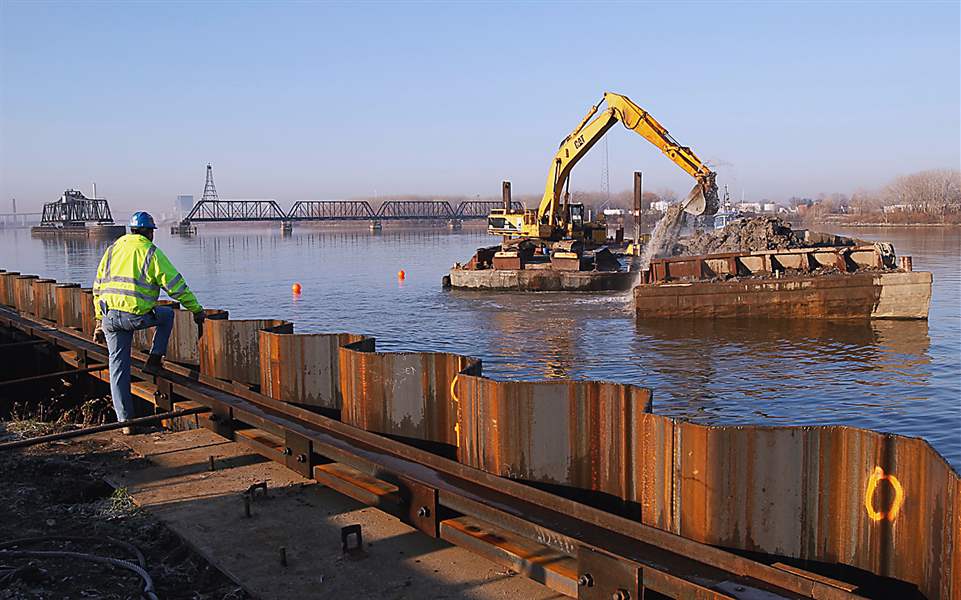
Kasich’s Great Lakes pledge $10M
Symposium opens with discussion on solutions to toxic algae
3/27/2014
THE BLADE
Buy This Image
ANN ARBOR — The Kasich administration’s plan to spend $10 million over two years on possible alternatives to continued open-lake dumping of channel dredgings was lauded by the U.S. Environmental Protection Agency’s top Great Lakes regulator as “terrific news” Wednesday.
“It is certainly something we support,” Susan Hedman, the federal EPA’s Midwest regional director and director of the agency’s Great Lakes National Program Office said during the opening question-and-answer session of a two-day Great Lakes symposium on the University of Michigan campus.
Although the event is focused on science and policy responses to fluctuating Great Lakes water levels, some of the first day’s discussion included water quality issues — especially that of microcystin, a highly toxic algae that has reappeared in western Lake Erie almost annually since 1995.
Microcystin has gained more attention of late because of its harm to Ohio’s valuable Lake Erie tourism and recreation industries.
In September, the toxin became so concentrated it knocked a municipal water-treatment plant in Ottawa County offline for the first time in Ohio history. Toledo was forced to spend an extra $1 million to fend off the threat to its water plant, too.
Numerous public officials now say last fall’s problems have raised the issue’s public-health profile.
Toledo’s port is the Great Lakes’ most heavily dredged because of its shallow channels and silt buildup from the Maumee River, a situation worsened in recent years by declining lake water levels.
While the National Oceanic and Atmospheric Administration and the Army Corps of Engineers expect lake levels to rebound to near-normal levels this summer because of the region’s heavy precipitation this winter, the corps is seeking an Ohio Environmental Protection Agency permit to increase dredging too.
The corps plans call for dumping all of the Toledo area’s dredged silt into North Maumee Bay, and its Cleveland-area plans include open-lake dumping there for the first time in years.
Much of the silt contains phosphorus, which supports algae growth. While fertilizer runoff and sewage overflows are generally considered the algae problem’s largest contributors, some scientists believe open-lake silt dumping hurts fish reproduction and boosts algae blooms.
The corps cites federal water-quality standards to justify its plans, stating that only silt with chemical concentrations meeting those standards goes back into the lake. Critics say the standards are too weak and don’t consider how swirling sediment harms the lake’s ecology.
Ms. Hedman said the federal agency supports the general concept of “beneficial reuse,” under which the material could be used to restore wetlands or stabilize shorelines — but at a cost previously unfunded.
“We are very strong proponents of beneficial reuse, and I’m pleased to hear of [the Kasich administration’s $10 million] commitment,” she said. “Whether there are [federal] financial resources available is an open question.”
The Kasich administration agreed to include $10 million for possible alternatives to open-lake disposal at the urging of several legislators, including State Sen. Randy Gardner (R., Ohio), who represents many farmers in the Maumee watershed.
The proposal is part of the governor’s $2.4 billion budget presented March 18 to the Ohio General Assembly.
Much of the symposium’s focus is on how climate change is affecting water levels and how greater adaptation efforts are needed, especially by industries reliant on steady water levels.
“The ebb and flow of Great Lakes water levels always have and always will be part of the business planning model in the Great Lakes region,” said Kathryn Buckner, president of the Council of Great Lakes Industries. “There has been some interest in our member communities about the long term.”
There are a few lakes in other parts of the world that hold more water, but none approach the Great Lakes’ combined surface areas and diversity of uses.
“There’s really no freshwater system on the planet that has such challenges,” Drew Gronewold, a University of Michigan researcher and hydrologist for NOAA’s Great Lakes Environmental Research Laboratory.
Despite this winter’s heavy snow, there is “a tremendous amount of uncertainty and variables in future water level projections related to climate change and precipitation,” he said.
Contact Tom Henry at: thenry@theblade.com or 419-724-6079.